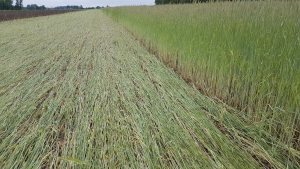By Rob Wallbridge
For a number of years now, no-till—the practice of planting and tending a crop without mechanically disturbing the soil—has been the darling of sustainable agriculture. “Minimizing soil disturbance” is a key principle of the regenerative agriculture movement, and for good reason. Organic farming is often criticized for its reliance on tillage, with the claim that no-till practices, even if they include chemical herbicides, are more sustainable. The criticism is warranted, although not entirely accurate. Let’s dig deeper:
Why till?
All but the staunchest of no-till advocates will admit that there are benefits to tillage, even with respect to soil health. Tillage incorporates residues into the soil, bringing them in greater contact with soil organisms and reducing nutrient losses. It can boost crop growth by adding oxygen to the soil and releasing carbon dioxide. Carefully-timed tillage can also aid in water management, either by breaking a crust and allowing water to soak in, or by creating a “dust mulch” at the soil surface by disrupting soil pore channels that increase evaporation rate.
Why not till?
On the other hand, tillage has been described as a “tsunami” in the microcosm of the soil, particularly to fungi. No form of cultivation improves soil structure. Excessive tillage will introduce too much oxygen, “burning up” soil organic matter and “burning out” nutrient-cycling soil microbes. The net result is soil that is prone to erosion and compaction. Over the long term, reducing or eliminating tillage will allow a higher diversity of soil life to function and flourish, leading to more carbon sequestration, better nutrient cycling, and reduced erosion.

Roller crimped rye cover crop in no-till organic field
The big picture
The conundrum facing most crop producers is that our major food and feed crops rely on a disturbance that reduces or eliminates competition for light, water and nutrients. That disturbance is going to be physical (tillage), chemical (herbicide), or biological (grazing). The challenge is to find a method that maximizes the benefits and minimizes the drawbacks of each system. The first step is to admit that there will be no “one answer” that fits all crops, all farms, all regions, all years. Innovative farmers are developing tools and techniques that balance short-term production goals against the long-term goals of building more resilient, self-sufficient soils, while minimizing the externalized costs of substances like chemical herbicides.
Minimizing soil disturbance, maximizing weed control
Modern mechanical weed control equipment like tine weeders, rotary hoes, and finger weeders are designed to operate at shallow depths and to control weeds at an early stage, minimizing soil disturbance and yield impact. Other tools like flame weeders and electric weeders kill weeds with zero soil disturbance.
Maintaining living roots and green cover
Food and shelter are just as important for soil microbes as any other form of life. Sowing cover crops between the rows of crops like corn and soybeans, underseeding clover into cereals, and relay cropping early and late season crops in alternating rows or strips are all means of extending the time and space that soil life is protected and fed.
Organic no-till
The practice of establishing a cover crop in the fall and rolling and crimping it the next spring to create a weed-suppressing, soil-protecting mulch for a crop has attracted a lot of attention and experimentation since the concept was first introduced by the Rodale Institute more than a decade ago. Achieving consistent results across seasons, regions, and crops has proven elusive however. Sufficient cover crop biomass to suppress weeds is critical, but variable growing conditions offer no guarantees. Balancing the nutrient requirements of the crops, especially heavier feeders like corn, against the nutrients tied up by a decaying cover crops can also be a challenge. At present, soybeans grown in a rye mulch is the most successful example of this system, but there is still a need for significantly more research into organic no-till systems.
The bottom line
The ultimate goal of a regenerative farm should be to use the minimum disturbance necessary to create an aerobic soil, eliminate compaction, control weeds and manage residues. If tillage requirements decline over time, soil health is headed in the right direction! In a healthy, fully-functioning soil, all of the benefits of tillage can be realized with biology rather than steel. Well-managed, well-timed cover crops can minimize weed pressure. Earthworms and other soil organisms are great at incorporating residues, and tap-rooted cover crops can break up compaction. Soils high in organic matter and biological activity will not be as prone to crusting or erosion and will be well-aerated. In many ways, tillage replaces biology, at a cost to the farmer and the soil; however, the full impact of these benefits must be earned over time.
Rob Wallbridge is an organic farmer and agronomy sales lead with SureSource Agronomy.





